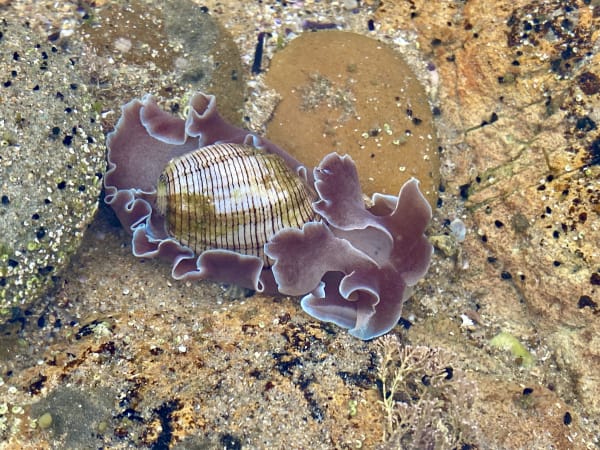I have a shell but it’s fragile
It doesn’t act as my home
I sometimes mate in a group
But usually I just hang out alone.
I bury myself in the sand
It’s the safest place to be
I have eyespots instead of eyes
So I sense the light, rather than see.
What on earth am I?

I’m a bubble snail.
I love bubble snails. The first time I ever spotted one, I couldn’t contain myself. I mean, they look like something you might find in a tropical aquarium or while snorkelling on some distant island and so I wasn’t expecting to find one during my regular rock pool wander around Sandon Point. And yet there it was, gliding gently across one of the many sandy-bottomed rock pools.
There are two species of bubble snails that I regularly find: the Rose Petal Bubble Snail, which has the frilly pink/brown mantle (there can be a fair bit of colour variation between individuals) and can get quite large and the teeny tiny, iridescent Red-Lined Bubble Snail, which is only a centimetre or two long. As with all things to be found out in the wild, sometimes you just have to spend a fair amount of time looking to spot them. I have walked right past these snails before, even though they’re both fairly distinctive looking. The rose-petal bubble snail will burrow down into the sand to search for worms which it loves to eat, and to protect itself, so sometimes all you’ll see is a bit of the frilled body peeking out from beneath the sand.

And sometimes you get lucky and can find a couple, or more, mating! They’re hermaphodites, meaning that they have both male and female reproductive organs and can simultaneously fertilise each other, and both can go on to lay eggs, which is an impressive and productive way to spend a morning! If you don’t spot the animals themselves, during their breeding season which runs from Summer through to early Autumn, you might instead spot their egg mass. The egg mass is a curled, creamy ribbon which when looked at closely, reveals thousands and thousands of minuscule individual eggs held together by mucous.
Even though the eggs are often out in the open and have no parental care or protection, they don’t seem to be eaten that often. The bubble snail’s bright colours are part of their defence mechanism, warning fish and crabs that they’re not the most delicious tasting creatures in the ocean. They may not taste that good but they sure are lovely.






